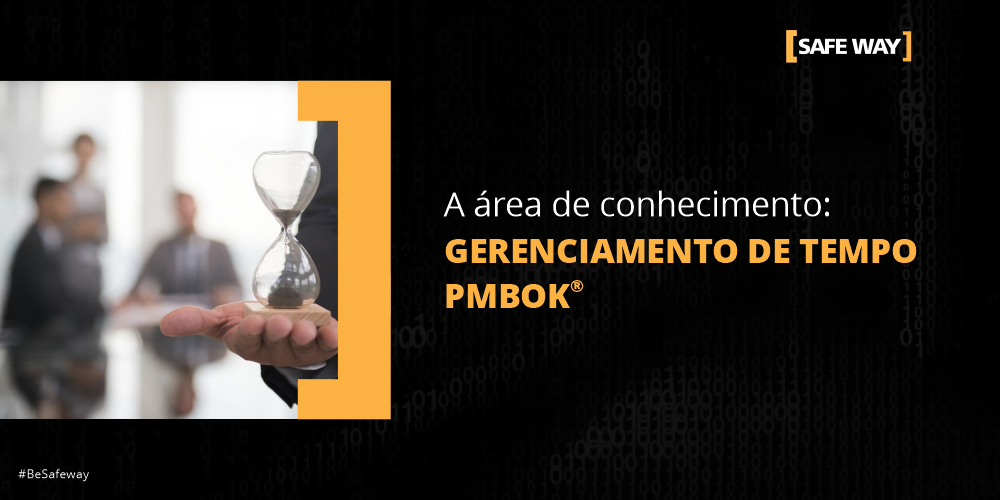The Knowledge Area: PMBOK® Time Management
*By Rodrigo Dantas
manage the time, considering the daily tasks and activities that we need to develop in a project it's a difficult mission. Sometimes we can waste the time with something that is not urgent at the time. And how to keep deadlines and optimize the management of time in the execution of the projects? With that in mind, many companies use time management strategies PMBOK® for the purpose of identifying demands, the profile of the team, as well as other factors that influence the time required to perform each step of a project. Thus, deadlines can be defined according to reality, avoiding delays, rework and overload of activities.
What is PMBOK®?
O PMBOK® (Project Management Body of Knowledge), consists of a standardization that identifies and conceptualizes processes, areas of knowledge, tools and techniques of project management. It's a kind of published project management encyclopedia, regularly reviewed by PMI (Project Management Institute). Its function is to standardize and disseminate the most efficient practices, tested and proven by managers of projects from around the world in one guide.
THE project management, has become essential for the good performance of a company in any area of activity. And, over the years, new techniques have been created and improved for managing priorities, deadlines and costs in projects.
The PMBOK® time management
O Time management PMBOK® occurs from a set of Law Suit structured in such a way that the team will have more chances to adhere to the deadlines agreed by the manager. Next, we will highlight each step proposed by this knowledge area:
- Schedule management planning: In this step, the PMBOK® helps the manager to identify the best policies and procedures to develop, manage and control the schedule of the project.
- Definition of activities: The core activities are identified for each of the deliverables of the project. Thus, we have a vision of the tasks that professionals must do to achieve the expected results at each stage.
- Activity sequencing: Definition of documentation, as well as the dependency relationships between each activity of the project. This helps to prioritize routines and assess how resources can be distributed more effectively. As a result, the routines will have a clear, objective logic.
- Identification of the resources involved in the activities: Its purpose is to estimate the type and amount of financial and operational resources that will be needed to carry out each of the activities of the project. As a result, the company can plan ahead and avoid a lack of resources and/or capacity during the project.
- Definition of deadlines: At this stage, the manager will define how many days will be needed to perform each of the activities that are part of the project. It is important to take into account goals, tools, internal rules and the profile of the teams involved in each stage, as well as possible deviations that will be subject to the activities.
- Schedule development: Here an analysis of each activity, its duration, restrictions and resources that are needed to create the project. This point is one of the most important for setting the schedule.
- Schedule control: The manager must control the changes that are made to the schedule, as well as their impact on the work flow. Remember all deviations and risks must be reflected in the schedule as well, this way we have a realistic view of the scenario of the project.
Conclusion
O management of forprojects it is not an easy task, it depends on the combination of several factors for the activities to develop smoothly and efficiently, minimizing conflicts or errors. Another factor of risk it's the time, which can hinder the company's revenues and the delivery of results.
The Law Suit proposed by the time management knowledge area of the PMBOK®, aim to ensure that the project finish in term stipulated and thus reduce the chances that it will extrapolate the deadlines, generating dissatisfaction, increasing costs and decreasing the lack of motivation and tension in the team.
About [SAFEWAY]
THE SAFEWAY is an Information Security company, recognized by its customers for offering high added value solutions, through Information Security projects that fully meet business needs. In these years of experience, we have accumulated, with great pride, several successful projects that have earned us credibility and prominence in our clients, which constitute in large part, the 100 largest companies in Brazil.
Today through over 22 strategic partnerships with global manufacturers and our SOC, SAFEWAY is considered a one stop shopping with the best technology solutions, processes and people.
Safeway can help customers better understand their Information Security needs, as well as the tools needed to detect, respond and mitigate their risks involving threats and regulatory issues. In this way, our professionals and expert consultants can help eliminate small problems before they become big ones. Security, Vulnerabilities and Fraud Management actively analyzes your company's security through monitoring activities, mitigating risks and attacks in the IT environment.




